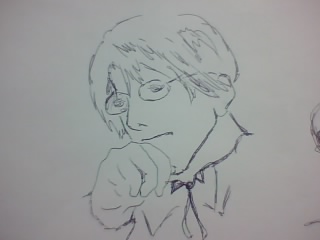What I thought I would do, is share some of the processes by which I am executing this task.
Part of the project involves contextualising already-completed artwork, both full color and black & white, and I am drawing my inspiration there from Ridley Scott, which is sort of difficult for me as I am not generally Mr. Scoot's biggest fan. One of the few things that excites me with Blade Runner, is the use of footage from other films, in particular from Scott's own Legend and from Stanley Kubrick's adaptation of The Shining. By ignoring the original intents of these shots, they achieve in Blade Runner a different perspective than they were designed for, but also a slightly disjunctive gloss in the film they now find themselves housed by.
David Lynch achieves something similar in his films, going back at least to Wild at Heart's loving Wizard of Oz dragshow, and beautifully heartwarmingly obvious in his allusions to many films in the recent Inland Empire. If I have to repurpose a unicorn, I want to find a way to make the stolen animal shout new things. And, like any sensible artist, I am up for exploring fresh avenues on two ghosts in a long hallway.
So, I can juggle the pre-existent images around and find new scenes for them to sit within, then adjust the scene as the picture offers me its take. Years ago, I would do something similar for newspaper articles, after discovering what photos might accompany the piece, and I find it relieving, actually, freeing me from having to worry about maintaining a precise and total eye on (what are, in this case, entirely fictional) scenes. Hopefully, the additional perspectives, the sense of secondary documentation I derive from this process will feed over the audience.
There is music commissioned and/or purchased for the project, so I have tried, similarly, to read passages while listening to random tracks. Even more than a shift of tone from appropriate to ironic or awkward, a good sting or an untimely silence can drive me to go back and adjust the prose, itself, even if I do not recommend the song be then allied with that scene.
Because I'm terrible at casting live actors as the voice, face, and mannerisms of characters I've developed, there were a few in the new project whom I cast ahead of time, sometimes fully, sometimes just in part (voice, bodytype, how they use a toothbrush). For example, Marcellas Reynolds knows he's the inspiration for the protagonist and the ultimate antagonist (in particular a swank Most Elligible cover photo of him from a year or so back), I put Christopher Walken in drag for a prison doctor, and made Grace Jones into Robin Hood.
I try to keep Guillermo Navarro in mind when mentally shooting certain scenes, and Mark Southon, for others. They'd probably do it better, but it helps me to think of what people more talented than I would do with a situation and copy what I get from that. This works in the arts as well as it does in building bookcases, repairing household items, and occasionally, scheduling events to make deadlines.
There are characters whom have come to me fully dressed, and those I have to kit up entirely on my own. Even for those who are pre-designed and pre-dressed, for the sake of understanding their history, their personality and relationships, in very surface (and artificial) terms, I will frequently devise what never gets taken our of their wardrobes, or what sits at the back of their cabinets, beneath their bed, or is forgotten in the smallest side-pocket of a traveling bag. We are as much our avoided and forgotten elements as we are our most frequently-revealed.
Other times a character has been visualised or given a voice that isn't exactly how I want to think of them, and so I draw up a temporary version for my own sake. A sketch somewhere between what I envision and the production will utilise, so I can bastardise myself into place.
We spend a lot of time with a young engineer, and most of the pre-existing material leaves him slender and smiley in a puffy shirt and suspenders. I wanted him to look at home swinging a hammer daily (and, recognizing that he could be short and skinny and still manage basic tool, I also recognize - as someone short and thin - that I only do so when necessary and don't go out of my way looking for a reason to, say, put a door on or fix a flooding sink) and in the story, he has a lot to be less-than-enthused with, at least early on. So, sketch sketch sketch and I come up with this sort of thing

where you can see my frightening attempt to ape the excellent Sanami Matoh and the great Mike Allred (and demonstrating how much better either of those artists are than I).
(In case anyone would like a closer look:
 )
)Or characters who probably will never be visualised professionally/commercially, but remain significant to the story (and to me), like the emotional backbone of the narrative, who is dead long before our story opens up,

who I turned into an awkward and matured version of Ozma of Oz, for reasons of personal resonance. I have to mourn and grieve, writing the narrative of those who miss her, and have to understand the tragedy long before it is revealed to the audience, and it even if this was just a six second sketch, keeping the image in mind helps me achieve that, and again, hopefully, this translates through the prose and into the eventual reader.


No comments:
Post a Comment